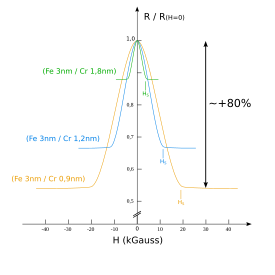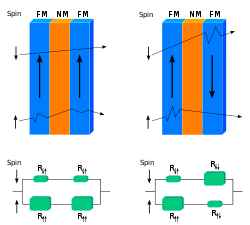Materials Science and Engineering/Magnetic Materials/Giant Magneto-Resistive Tunnelling Effect
The development of devices that sense and store information is driven by the demand for more capable computers. The utilization of the phenomenon of giant magneto-resistance (GMR) has led to the creation of more sensitive sensors that read bits coded on magnetized regions of disks. An understanding of GMR has led to a large increase in information storage capacity. The phenomenon of GMR has also been of interest to physicists.

The magneto-resistance effect (MR effect) describes the change in the electrical resistance of a material due to the application of a magnetic field. Research advances related to electron spin, tunneling effects, and production of ultra-thin layers have made possible the design of electrical devices based on quantum mechanical effects of the electron. The giant magneto-resistance effect is dependent on spin properties of electrons. Several other magneto-resistive effects have been discovered, and they are classified under XMR effects or XMR technology.
An example of a structure where the giant magneto-resistive effect is observed consists of a layer of copper, a normal metal, between layers of cobalt, a ferromagnetic material. When the magnetic moments of the ferromagnetic layers are parallel, there is less resistance to the flow of current. In current devices, the direction of magnetization of one layer is typically fixed in one direction, while the other is determined by an external field. The difference of resistance between parallel and anti-parallel configurations is 10-15% in current devices.

The effect of GMR is similar to phenomenon of polarization. In a polarization experiment, light cannot pass through if two polarizers are perpendicular to one another. Similarly, one magnetic layer may allow electrons of one type of spin to pass, and, if the second structure is aligned in the same direction, current can easily pass through. If the second layer is misaligned, neither spin channel can pass through the structure easily, and the electrical resistance is high.
Early studies in which GMR was first observed may have been published in 1987. The patent of the effect is owned by Peter Grunberg, who led a team at the Julich Research Centre and observed the effect in trilayers of Fe/Cr/Fe. The effect was simultaneously and independently observed in multilayers of Fe/Cr.
Three types of GMR are multilayer, granular, and spin-valve GMR. The effect was first observed in multilayer configurations and the effect in granular GMR is not as large as multilayer GMR. Spin-valve GMR is the most useful industrially, and the magnetic recording industry is researching structures that are very sensitive to magnetic fields. IBM and Seagate develop high density disk and tape playback heads. Additional applications include avionic compasses, swipe-card readers, wheel rotation sensors in ABS brakes, and current sensors for use in safety powerbreakers and electricity meters.
References
edit- Giant Magnetoresistive Effect w:Giant_magnetoresistive_effect
- Giant Magnetoresistance [1]
- Science Week Materials Science: On Magnetoresistive Tunnel Junctions [2]
- New Magneto Coupler on magnetic GMR-technology [3]
- Giant Magnetoresistance of (001)Fe/(001)Cr Magnetic Superlattices [4]